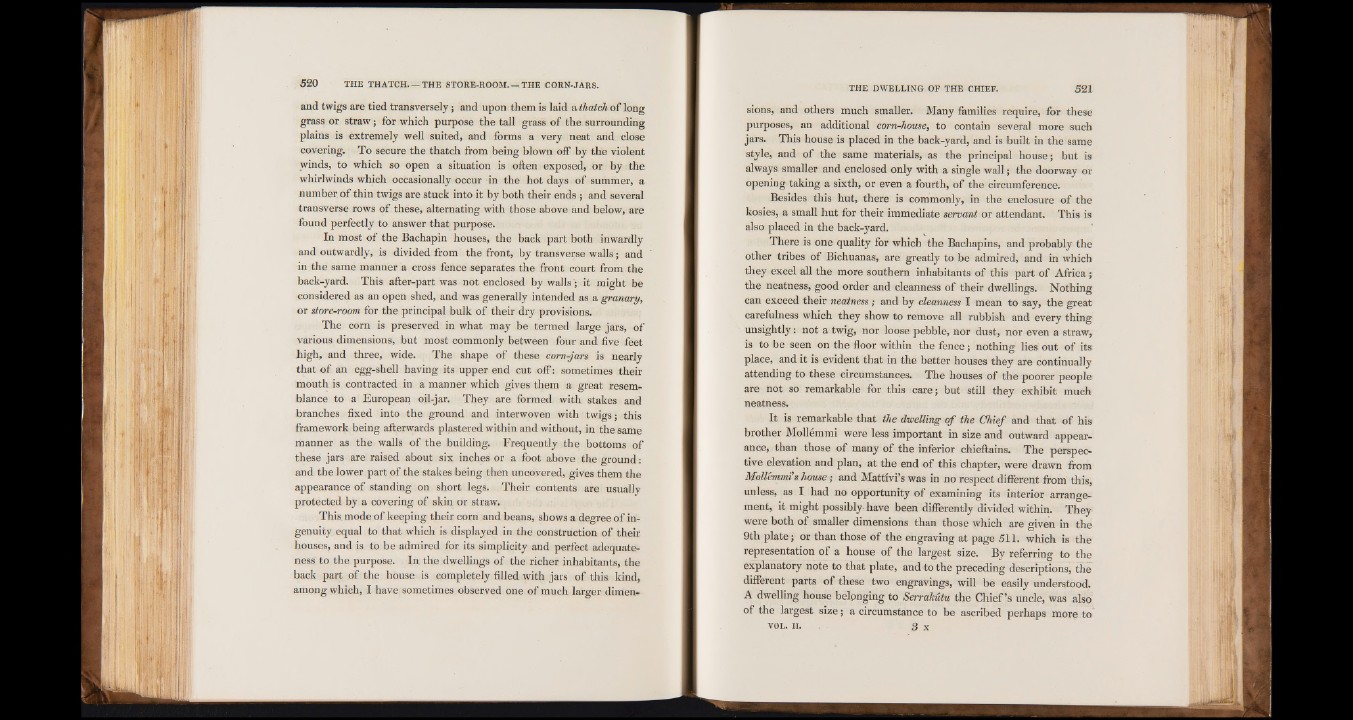
and twigs are tied transversely; and upon them is laid a thatch of long
grass or straw; for which purpose the tall grass of the surrounding
plains is extremely well suited, and forms a very neat and close
covering. To secure the thatch from being blown off by the violent
winds, to which so open a situation is often exposed, or by the
whirlwinds which occasionally occur in the hot days of summer, a
number of thin twigs are stuck into it by both their ends ; and several
transverse rows of these, alternating with those above and below, are
found perfectly to answer that purpose.
In most of the Bachapin houses, the back part both inwardly
and outwardly, is divided from the front, by transverse walls; and
in the same manner a cross fence separates the front court from the
back-yard. This after-part was not enclosed by walls; it might be
considered as an open shed, and was generally intended as a granary,
or store-room for the principal bulk of their dry provisions.
The corn is preserved in what may be termed large jars, of
various dimensions, but most commonly between four and five feet
high, and three, wide. The shape of these corn-jars is nearly
that of an egg-shell having its upper end cut off: sometimes their
mouth is contracted in a manner which gives them a great resemblance
to a European oil-jar. They are formed with stakes and
branches fixed into the ground and interwoven with twigs; this
framework being afterwards plastered within and without, in the same
manner as the walls of the building. Frequently the bottoms of
these jars are raised about six inches or a foot above the ground:
and the lower part of the stakes being then uncovered, gives them the
appearance of standing on short legs. Their contents are usually
protected by a covering of skin or straw.
This mode of keeping their corn and beans, shows a degree of ingenuity
equal to that which is displayed in the construction of their
houses, and is to be admired for its simplicity and perfect adequateness
to the purpose. In the dwellings of the richer inhabitants, the
back part of the house is completely filled with jars of this kind,
among which, I have sometimes observed one of much larger dimensions,
and others much smaller. Many families require, for these
purposes, an additional corn-house, to contain several more such
jars. This house is placed in the back-yard, and is built in the same
style, and of the same materials, as the principal house; but is
always smaller and enclosed only with a single wall; the doorway or
opening taking a sixth, or even a fourth, of the circumference.
Besides this hut, there is commonly, in the enclosure of the
kosies, a small hut for their immediate servant or attendant. This is
also placed in the back-yard.
There is one quality for which the Bachapins, and probably the
other tribes of Bichuanas, are greatly to be admired, and in which
they excel all the more southern inhabitants of this part of Africa ;
the neatness, good order and cleanness of their dwellings. Nothing
can exceed their neatness; and by cleanness I mean to say, the great
carefulness which they show to remove all rubbish and every thing
unsightly: not a twig, nor loose pebble, nor dust, nor even a straw,
is to be seen on the floor within the fence; nothing lies out of its
place, and it is evident that in the better houses they are continually
attending to these circumstances. The houses of the poorer people
are not so remarkable for this care; but still they exhibit much
neatness,
It is remarkable that the dwelling of the Chief and that of his
brother Mollemmi were less important in size and outward appearance,
than those of many of the inferior chieftains. The perspective
elevation and plan, at the end of this chapter, were drawn from
Mollemmis house; and Mattivi’s was in no respect different from this,
unless, as I had no opportunity of examining its interior arrangement,
it might possibly have been differently divided within. They
were both of smaller dimensions than those which are given in the
9th plate; or than those of the engraving at page 511. which is the
representation of a house of the largest size. By referring to the
explanatory note to that plate, and lo the preceding descriptions, the
different parts of these two engravings, will be easily understood.
A dwelling house belonging to Serrakhtu the Chief’s uncle, was also
of the largest size; a circumstance to be ascribed perhaps more to
VOL. II. 3 x